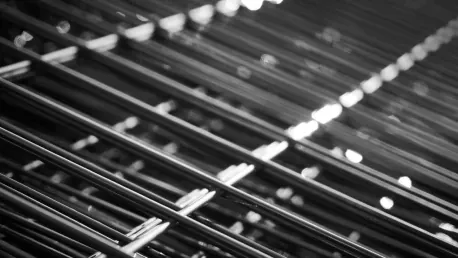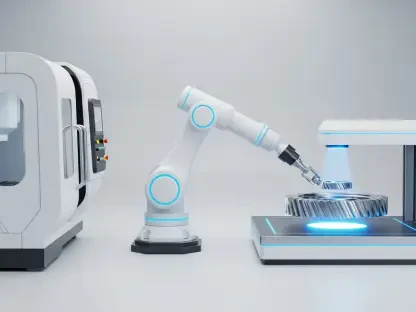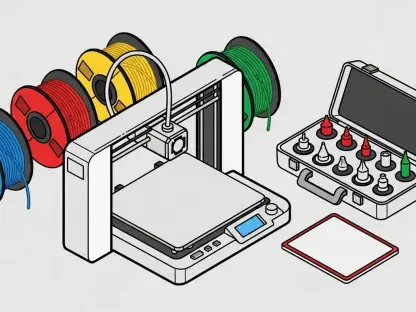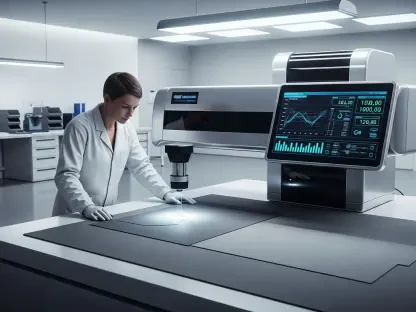The metal fabrication industry in North America is experiencing transformative changes, driven by advancements in technology, increasing demand for customized solutions, and economic factors. With substantial growth projections, the market is poised for significant expansion and innovation.
Surge of Additive Manufacturing
The Additive Transformation
Additive manufacturing, also known as 3D printing, is revolutionizing the metal fabrication landscape. By building components layer by layer, this technology reduces material waste and allows for intricate designs that were previously impossible. Unlike traditional subtractive methods, which cut away material to form a part, additive manufacturing offers the advantage of creating complex, high-strength components with precision.
Industries such as aerospace and healthcare are at the forefront of adopting additive manufacturing. These sectors leverage the technology to create lightweight, high-strength components, significantly improving efficiency and precision. For instance, the aerospace industry uses 3D printing to produce engine parts that are both lighter and more durable. In healthcare, custom implants and prosthetics tailored to individual patients are becoming more common, showcasing the technology’s adaptability.
Production Benefits
The National Institute of Standards and Technology has underscored that additive manufacturing can cut production time by up to 50% for complex parts. This not only streamlines the manufacturing process but also opens new revenue streams for companies investing in this advanced technology. Furthermore, the ability to rapidly prototype during the design phase shortens development cycles, enabling faster time-to-market for new products.
By reducing material waste and production time, manufacturers can achieve cost savings that enhance competitiveness. The precision of additive manufacturing also means fewer errors and higher-quality end products. As companies continue to invest in these technologies, the overall efficiency and output of the metal fabrication market are set to increase, offering promising growth opportunities.
Customized Fabrication Solutions
In an ever-evolving market, the necessity for tailored manufacturing services has never been more crucial. Custom fabrication solutions offer businesses the flexibility to create unique products that meet their specific needs and requirements.
Rising Demand for Customization
Customization is a significant driver in the metal fabrication market, fueled by the need for tailored solutions across various sectors. The construction industry, in particular, requires unique metal structures for modern architectural designs. From custom steel beams to intricate metal facades, the demand for bespoke components is growing. Moreover, the shift towards sustainable and energy-efficient buildings also requires specialized metal parts.
The energy sector, especially with its focus on renewable energy projects, demands specialized components like custom-fabricated brackets for solar panels and turbine parts for wind energy. Companies offering customized products often see higher customer retention rates, reflecting the growing trend toward “mass customization.” This approach allows manufacturers to cater to specific client needs while maintaining the scalability and efficiency of mass production.
Flexible Manufacturing Processes
To stay competitive, fabricators are adopting flexible manufacturing processes and advanced software tools. These advancements enable them to produce bespoke solutions without compromising scalability, meeting specific client needs efficiently. For example, computer-aided design (CAD) and computer-aided manufacturing (CAM) software allow for precise customizations and quick adjustments to designs.
The integration of flexible manufacturing processes also means that companies can quickly respond to changing market demands and customer specifications. Advanced software tools can facilitate real-time adjustments, ensuring that even last-minute changes do not disrupt production schedules. This flexibility is crucial in sectors like automotive manufacturing, where customization can range from vehicle frames to specialized parts.
Skilled Labor and Trade Challenges
Skilled Labor Shortages
Despite the industry’s growth, a significant restraint is the shortage of skilled labor. Specialized tasks like welding and machining require extensive training, but there is a widening gap between the demand and availability of such skilled workers. Reports from the Manufacturing Institute indicate that the U.S. manufacturing sector could face a shortfall of millions of skilled workers by 2030.
This labor shortage delays project timelines and increases operational costs, as companies must invest in training or outsource work to meet their needs. The Bureau of Labor Statistics has noted that the employment growth rate for metal fabrication occupations is slow, emphasizing the urgent need for workforce development programs. Companies are increasingly turning to automation and robotics to mitigate the impact, but skilled human workers remain irreplaceable for certain complex tasks.
Impact of Trade Policies and Tariffs
Trade policies and tariffs significantly influence the global economy, affecting both domestic industries and international relations. Changes in these policies can lead to shifts in market dynamics, impacting prices, supply chains, and competitive advantages. Understanding the broader implications of trade agreements and disputes is crucial for businesses and policymakers alike.
Trade policies and tariffs also pose significant challenges for the metal fabrication market. The United States-Mexico-Canada Agreement (USMCA) has introduced stricter rules, which have led to increased costs for fabricators relying on imported materials. These regulations aim to boost domestic production but can place financial strain on companies that depend on a global supply chain.
Smaller firms, in particular, feel the strain of these trade barriers, as they have limited bargaining power and resources to absorb the additional costs. The Peterson Institute for International Economics estimates that steel tariffs have added substantial amounts to manufacturing costs, creating uncertainty for fabricators. Establishing a reliable and cost-effective supply chain is critical for maintaining competitiveness in this challenging environment.
Opportunities in Modular Construction
Emerging Role in Modular Construction
Modular construction is gaining traction, presenting a substantial opportunity for metal fabricators. This construction method relies heavily on prefabricated metal components fabricated off-site and assembled on-site. The standardized but customizable nature of modular construction suits the capabilities of metal fabricators, who can produce elements like steel frames and modular panels.
The U.S. Census Bureau has reported significant expenditures in non-residential construction, with modular solutions accounting for an increasing share. Metal fabricators can benefit greatly by producing standardized yet customizable components, aligning with the modular design’s needs for sustainable and efficient construction practices. This method reduces on-site labor costs and construction time, enhancing overall project efficiency.
Infrastructure Investments
Significant infrastructure investments are driving demand for modular construction. The U.S. government has announced plans to invest heavily in infrastructure projects, including roads, bridges, and public buildings, which will require substantial quantities of fabricated metal components. This offers a lucrative market for fabricators prepared to adapt to the modular construction trend.
With modular construction becoming more prevalent, metal fabricators can position themselves as essential partners in delivering these innovative building solutions. By aligning their production capabilities with the needs of modular construction, fabricators can diversify their client base and improve their market position. This trend also aligns with broader goals of sustainability and efficiency in the construction industry.
Smart Manufacturing Solutions
Integration of Smart Technologies
The adoption of smart manufacturing technologies such as the Internet of Things (IoT), artificial intelligence (AI), and predictive maintenance is transforming the metal fabrication market. Implementing IoT solutions can lead to significant operational cost reductions and productivity gains. Sensors and IoT-enabled devices can monitor equipment performance in real-time, allowing for predictive maintenance that reduces downtime.
AI-driven analytics optimize material usage, minimize waste, and enhance sustainability. For instance, AI algorithms can predict equipment failure before it occurs, enabling preventive measures. A report by PwC indicates that manufacturers adopting IoT solutions can achieve substantial reductions in operational costs. These technological advancements not only improve efficiency but also contribute to more sustainable practices in manufacturing.
Cybersecurity Challenges
However, the integration of connected systems also introduces cybersecurity risks. Small and medium-sized fabricators are particularly vulnerable due to limited IT resources and outdated security protocols. Cyberattacks on industrial systems have surged, and a breach can disrupt operations, compromise sensitive data, and lead to costly downtime.
Investing in robust cybersecurity infrastructure and employee training is essential, though it can strain budgets and divert focus from core operations, presenting a challenging balancing act. Studies highlight that a significant percentage of manufacturers lack comprehensive cybersecurity strategies, leaving them exposed to threats. Addressing these risks requires coordinated efforts between technology providers and fabricators to ensure robust defenses.
Environmental Compliance
Rising Environmental Compliance Costs
Environmental compliance costs present another challenge for the metal fabrication industry. Strict emissions standards and the transition to cleaner technologies require substantial investments. The Environmental Protection Agency mandates stringent regulations, pushing fabricators towards greener practices that, while beneficial, come with high initial costs.
Meeting these regulatory demands is financially taxing, particularly for smaller fabricators who risk non-compliance penalties or reduced competitiveness if they cannot afford the necessary upgrades. The National Association of Manufacturers notes that compliance costs can be significant, especially for businesses already operating on thin margins. This creates pressure to find economically viable solutions that align with environmental goals.
Commitment to Sustainability
Despite these costs, sustainability remains a priority. Leading companies are investing in energy-efficient equipment, minimizing waste, and incorporating recycled materials into their supply chains. This commitment to green manufacturing practices serves as a competitive differentiator. Companies that position themselves as environmentally responsible can attract clients who prioritize sustainability.
The move toward sustainable practices is not only driven by regulatory compliance but also by market demand. Clients are increasingly looking for partners that adhere to eco-friendly practices, providing an incentive for fabricators to invest in greener technologies. Over time, these investments yield returns in the form of reduced operational costs and enhanced market reputation.
Market Segment Insights
Process and Raw Material Breakdown
The market is divided by processes such as welding, machining, and cutting, with welding holding the largest share due to its widespread use across multiple industries. Welding is essential for assembling metal structures in construction, automotive, and aerospace applications, making it a core process in metal fabrication.
In terms of raw materials, steel dominates the market, favored for its strength and versatility, while aluminum is the fastest-growing segment, driven by demand for lightweight materials in the automotive and aerospace industries. Steel is integral to heavy industrial applications, whereas aluminum is essential for sectors requiring lightweight, corrosion-resistant materials. The contrasting demands highlight the diverse needs within metal fabrication.
End-Use Segments
The construction sector is the largest end-use segment, with significant demand for fabricated metal components in residential and commercial projects. The market for metal fabrication in construction is bolstered by the need for durable, high-quality materials that can support complex architectural designs and infrastructure projects.
The energy and power segment is rapidly rising, driven by renewable energy projects such as wind turbines and solar panel installations. These projects require specialized, high-performance metal components to ensure efficiency and longevity. The focus on renewable energy not only aligns with environmental goals but also opens new avenues for metal fabricators to explore and innovate.
Regional Market Dynamics
Dominance of the United States
The United States leads the North American metal fabrication market, with its robust industrial base and high demand for fabricated metals in sectors like automotive, aerospace, and construction. The U.S. Bureau of Economic Analysis has reported substantial contributions from manufacturing to the GDP, with metal fabrication playing a critical role. The country’s advanced infrastructure, skilled workforce, and technological innovation make it a central hub for metal fabrication.
The dominance of the U.S. in the market is also bolstered by strong domestic demand and supportive government policies that encourage manufacturing growth. The integration of cutting-edge technologies and continuous investment in skilled labor further solidify the country’s leadership in the market. The emphasis on high-quality production and innovation positions U.S. fabricators favorably in the global landscape.
Growth Prospects in Canada
Canada is likely to be the fastest-growing market in North America, with increased investments in renewable energy projects and infrastructure development. Natural Resources Canada predicts significant growth in wind and solar energy capacity, requiring substantial metal components. The Canadian government has also announced plans to invest heavily in infrastructure projects over the next decade, boosting demand for fabricated metals.
Canada’s focus on sustainable practices and its abundant raw material resources will further drive its growth. The country’s commitment to green energy and eco-friendly policies creates a favorable environment for fabricators to expand their operations. As the market evolves, fabricators in Canada are well-positioned to capitalize on emerging opportunities in both traditional and renewable energy sectors.
Key Market Players and Competitive Landscape
The North American metal fabrication market is highly competitive, with many companies striving to meet the growing demand for customized and high-quality metal products. Large companies often dominate due to their advanced technology and strong supply chains. However, smaller businesses also compete by focusing on niche markets and providing specialized services. Key players in the market include O’Neal Manufacturing Services, BTD Manufacturing, and Mayville Engineering Company (MEC).
O’Neal Manufacturing Services
O’Neal Manufacturing Services holds a dominant position in the North American metal fabrication market, capitalizing on the growing demand for customized and large-scale metal components. The company offers end-to-end fabrication services that include machining, welding, assembly, and finishing. O’Neal’s strategic emphasis on supply chain integration and lean manufacturing allows it to meet evolving customer expectations for faster turnaround times and high-quality outputs.
The company’s ability to deliver comprehensive solutions makes it a preferred partner for clients across various industries. Their focus on continuous improvement and investment in cutting-edge technologies ensures that they remain competitive in an ever-evolving market. O’Neal’s approach to staying ahead of industry trends and customer needs solidifies its position as a market leader.
BTD Manufacturing
BTD Manufacturing has cemented its leadership by embracing automation and digital manufacturing trends. The company’s proficiency in value-added services such as laser cutting, robotic welding, and advanced machining has enabled it to serve critical industries like agriculture, construction, and industrial machinery more effectively. BTD’s ability to deliver tailored, technology-driven solutions enhances product innovation and operational agility for its clients.
Their commitment to investing in state-of-the-art equipment and a skilled workforce allows them to provide high-precision, customized solutions. BTD’s strategic focus on leveraging technology for efficiency and innovation ensures they meet and exceed client expectations, making them a formidable competitor in the market.
Mayville Engineering Company (MEC)
Mayville Engineering Company (MEC) is a leading U.S.-based precision manufacturer of products and components for various industries, including heavy-duty trucks, automotive, agriculture, construction, and commercial vehicles.
Mayville Engineering Company maintains a strong market presence through its diversified capabilities and commitment to expanding its contract manufacturing services. MEC’s ability to offer localized, vertically integrated solutions has strengthened its value proposition to clients across multiple sectors. The company’s growth strategy, supported by acquisitions and continuous investments in automation and lean processes, has positioned it to capitalize on the increasing need for flexible, high-volume production capabilities.
MEC’s adaptive approach to market demands and its broad range of manufacturing services provide a strong foundation for sustained growth. Their emphasis on localized solutions and continuous innovation allows them to maintain a competitive edge in a dynamic industry landscape.
Top Strategies Used by Key Market Participants
Sustainability and Green Manufacturing
Sustainability has become a core focus for key players as industries across North America push for eco-friendly practices and carbon reduction. Leading metal fabrication companies are adopting green manufacturing strategies, which include investing in energy-efficient equipment, minimizing material waste, and incorporating recycled metals into their supply chains. This commitment to sustainability serves as a competitive differentiator.
By promoting sustainable practices, these companies not only meet regulatory compliance but also attract clients who value environmental responsibility. The shift towards green manufacturing is expected to drive future growth, as market demand increasingly favors eco-friendly production methods. Companies that prioritize sustainability are likely to see long-term benefits in both market positioning and customer loyalty.
Reshoring and Localization
The reshoring trend has gained momentum as companies seek to mitigate supply chain disruptions and reduce reliance on overseas manufacturing. Major players in the North American metal fabrication market are investing in expanding and modernizing domestic facilities to better serve local and regional clients. This localization strategy improves lead times, enhances supply chain resilience, and enables closer collaboration with customers.
Reshoring also aligns with broader economic goals to strengthen domestic manufacturing capabilities and create jobs. By bringing production closer to home, companies can better manage logistics and minimize the risks associated with global supply chain uncertainties. This focus on localized production is becoming a key strategic advantage in the competitive landscape.
Customization and Value-Added Services
To differentiate themselves from competitors, market leaders focus on delivering highly customized solutions and value-added services tailored to each client’s unique requirements. This strategy includes offering services like engineering support, prototyping, assembly, and logistics assistance. Customization enhances customer satisfaction, improves project outcomes, and builds brand loyalty in a market where precision and responsiveness are critical.
The emphasis on value-added services also enables companies to offer comprehensive solutions, addressing a wider range of customer needs. By integrating additional services and providing end-to-end solutions, fabricators can enhance their market position and create more robust, long-term relationships with clients. This focus on customized services is essential for maintaining competitiveness in a dynamic and demanding market.
Recent Market Developments
In March 2025, the American President Donald Trump implemented a 25% tariff on all steel and aluminum imports. This move aims to boost domestic production and stabilize the supply chain in North America, with significant implications for businesses and consumers reliant on imported metals.
In February 2025, Australia launched a $636 million (A$1 billion) fund to support the production and supply chains of green iron. An initial A$500 million was allocated to rescue the Whyalla steelworks in South Australia, which had faced financial challenges. This investment is part of a broader A$1.9 billion package aimed at revitalizing the steel industry and aligning with the nation’s clean energy transition goals.
In December 2024, ArcelorMittal, a leading global steel manufacturer, announced the delay of its planned investments in greener steelmaking technologies in Europe. The company cited policy uncertainties within the European Union, including concerns over the proposed carbon border tax and competition from low-cost Chinese steel imports.
Market Segmentation
This research report on the North American metal fabrication market is segmented and sub-segmented based on various categories.
By Process:
- Welding
- Machining
- Forming
- Shearing
- Cutting
- Folding
- Rolling
- Stamping
- Punching
By Raw Material:
- Steel
- Aluminum
- Others
By End-use:
- Construction
- Automotive
- Manufacturing
- Energy and Power
- Electronics
- Others
By Country:
- The United States
- Canada
- The rest of North America
Conclusion
The metal fabrication industry in North America is undergoing significant changes due to technological advancements, increased demand for tailored solutions, and various economic factors. These changes are revolutionizing how businesses operate, presenting new opportunities for growth and innovation. As companies seek to meet specific customer requirements, they are investing in cutting-edge technologies such as automation, 3D printing, and advanced robotics. These tools not only enhance efficiency and precision but also enable the creation of highly customized products in shorter time frames.
Economic factors play a crucial role in shaping the metal fabrication market. The recent boost in construction and infrastructure projects, coupled with the resurgence of the manufacturing sector, is driving substantial demand for fabricated metal products. Additionally, increased consumer spending and the growth of the automotive and aerospace industries further contribute to the rising demand.
Projections indicate robust growth for the metal fabrication market in the coming years. Businesses that adapt to these transformative changes, prioritize continuous learning, and embrace technological advancements will likely thrive. Innovation and customization are key, helping the industry not only expand but also meet the evolving needs of its diverse customer base. The future looks promising for North American metal fabricators, poised for significant expansion and evolution.









